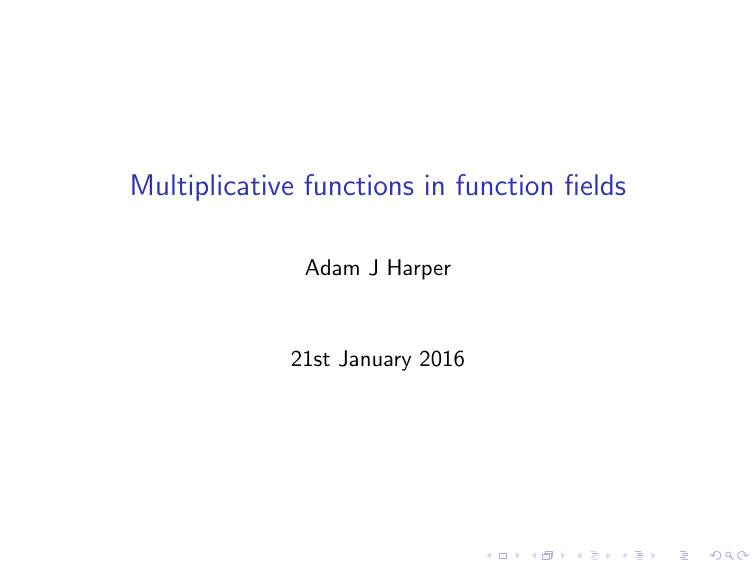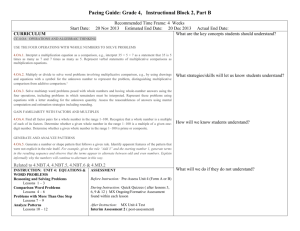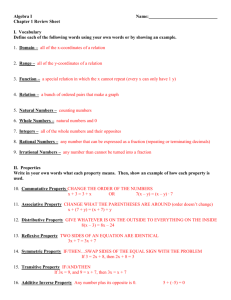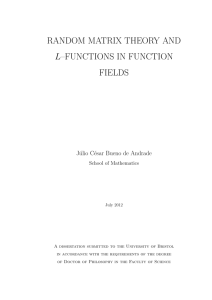Multiplicative functions in function fields
advertisement

Multiplicative functions in function fields Adam J Harper 21st January 2016 Plan of the talk: I The talk reports on joint work with A. Granville and K. Soundararajan. I Review of multiplicative functions over the integers, and in function fields. I Halász-type theorems on mean values, and ideas about the proofs. I (If time permits) Comment on a difference between the integers and function fields (variation of mean values). Multiplicative functions, I Over the integers, a multiplicative function f : N → C is one that satisfies f (mn) = f (m)f (n) ∀ (m, n) = 1. The classical generating function associated with f is the Dirichlet series ∞ X f (n) . F (s) := ns n=1 If we have sufficient rough control on the size of f (n) (e.g. the pointwise bound |f (n)| ≤ 1), then F (s) will converge absolutely in the half plane <(s) > 1, and there will satisfy ! ∞ Y X f (p k ) . F (s) = 1+ p ks p k=1 Multiplicative functions, II Over the polynomial ring Fq [x], with q a prime power, a multiplicative function f : M → C is one that satisfies ∀ coprime F , G ∈ M, f (FG ) = f (F )f (G ) where M denotes the set of monic polynomials in Fq [x]. The natural generating function is the power series X F(z) := f (F )z deg(F ) . F ∈M If we have the pointwise bound |f (F )| ≤ 1, then F(z) will converge absolutely in the disc |z| < 1/q (since there are q n monic polynomials of degree n), and there will satisfy ! ∞ Y X k kdeg(P) F(z) = 1+ f (P )z , P∈P k=1 where P denotes the set of irreducible monic polynomials in Fq [x]. Mean values Returning to the integer setting, we would like to use information about the Dirichlet series F (s) to deduce things about the mean P value (1/x) n≤x f (n). (And similarly in the function field setting.) Key point: If we are lucky, the values f (n) might be so well behaved that F (s) enjoys very good properties, such as analytic continuation to a large part of the complex plane. Lots of classical analytic number theory works like this (think of Dirichlet characters χ(n), for example). But what can we do if we don’t know so much about F (s)? To simply state some results, let Λf (n) denote the Dirichlet series P Λf (n) coefficients of −F 0 (s)/F(s) = ∞ n=1 ns , where <(s) > 1, say. Q P f (p k ) Also let Fx (s) := p≤x 1 + ∞ denote the finite Euler k=1 p ks product, truncated to primes p ≤ x. Theorem (Halász’s theorem over the integers) Suppose f : N → C is a multiplicative function, and suppose |Λf (n)| ≤ Λ(n) for all n. Then for all large x we have 1 X log log x f (n) (1 + M)e −M + , x log x n≤x where the quantity M = M(f , x) is defined by Fx (1 + it) −M . e log x := max 1 + it |t|≤log x Because of the condition |Λf (n)| ≤ Λ(n), we have ! ∞ X Y 1 1+ |Fx (1 + it)| ≤ log x, pk p≤x k=1 so we certainly always have M 1. In my opinion, the crucial feature of Halász’s theorem is that it is a general lossless bound. In other words, if we use the trivial lower bound M 1 in the theorem, we recover the trivial bound 1 X f (n) 1. x n≤x If we have any better bound for M, then we will get a non-trivial mean value bound. This feature is quite rare in most analytic arguments (typically one “gives away” a few logarithms at the beginning). In the function field setting, the power series P let Λf (F ) denote F0 deg(F ) coefficients of z F (z) = F ∈M Λf (F )z . Note that here, the analogue of the von Mangoldt function is given by Λ(F ) = deg(P) if F is a power of the irreducible P, and Λ(F ) = 0 otherwise. Also let Fn (z) be the power series corresponding to the multiplicative function with Λf (F ) = 0 if deg(F ) ≥ n. Theorem (Granville, H., Soundararajan, 2015) Suppose f : M → C is a multiplicative function, and that |Λf (F )| ≤ Λ(F ) for all F . Then for all large n we have 1 n q X f (M) (1 + M)e −M , M∈M, deg(M)=n where now M = M(f , q, n) is defined by e −M n := max |Fn (z)|. |z|=1/q Idea of the proof (in function fields), I We can write Z X 1 dz 1 1 Fn (z) n+1 + small error. f (M) = n n q q 2πi |z|=1/q z M∈M, deg(M)=n Bounding the integral trivially using the triangle inequality, we get Z q |Fn (z)||dz| ≤ max |Fn (z)|, ≤ 2π |z|=1/q |z|=1/q so we are off from what we want by roughly a factor of n. Key point: It is often quite difficult to bound an L1 norm in an efficient way, and even bounding an L2 norm may not give a good result. Motivated by additive number theory (the circle method), we want to have three factors around, so we can pull one out and apply Parseval to the other two factors. Idea of the proof (in function P fields), II n So we want to write (1/q ) M∈M, f (M) as an integral of a deg(M)=n product of three power series, up to a small error. To get two factors, a natural thing is to write Z X 1 dz 1 1 zFn0 (z) n+1 f (M) ≈ n n q nq 2πi |z|=1/q z M∈M, deg(M)=n = 1 1 nq n 2πi Z |z|=1/q zFn0 (z) Fn (z) Fn (z) dz z n+1 . Note here that we have gained a factor 1/n on the outside of the 0 P n integral, and z F Λf (F )z deg(F ) is an F ∈M, Fn (z) = deg(F )≤n−1 arithmetically meaningful power series (whose average behaviour we could hope to control). Idea of the proof (in function fields), III To get three factors there are various options, for example we can write 0 0 Z 1 zFn (z) zFn (z) 0 Fn (z) = 1+ zFn (tz)dt Fn (z) Fn (z) 0 0 Z 1 zFn (z) tzFn0 (tz) dt = 1+ Fn (tz) . Fn (z) Fn (tz) t 0 The contribution from the 1 in the bracket can be absorbed into our small error, so it remains to bound 0 Z 1Z 1 1 zFn (z) tzFn0 (tz) dt Fn (tz)dz . nq n 2πi 0 |z|=1/q Fn (z) Fn (tz) t One can pull out a factor max |Fn (tz)| from the inner integral, and use Cauchy–Schwarz and Parseval to efficiently bound everything else there.



![is a polynomial of degree n > 0 in C[x].](http://s3.studylib.net/store/data/005885464_1-afb5a233d683974016ad4b633f0cabfc-300x300.png)



